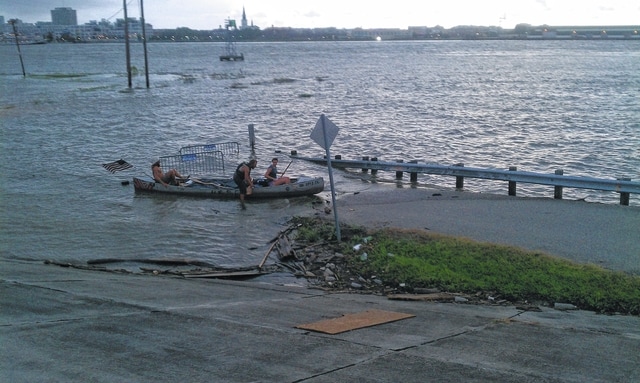
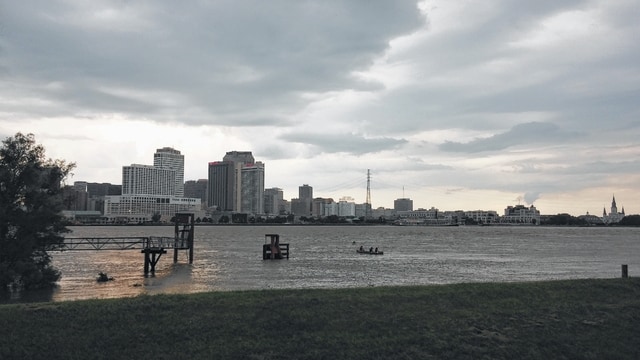
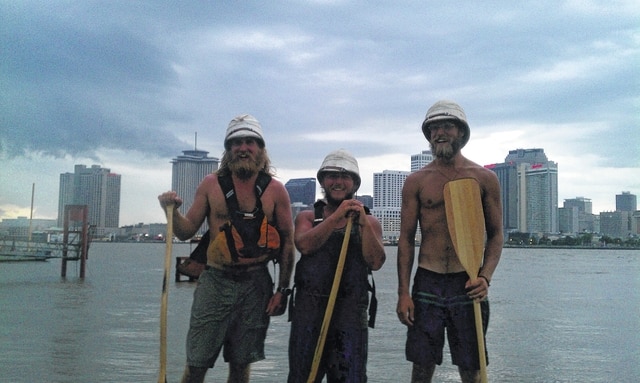
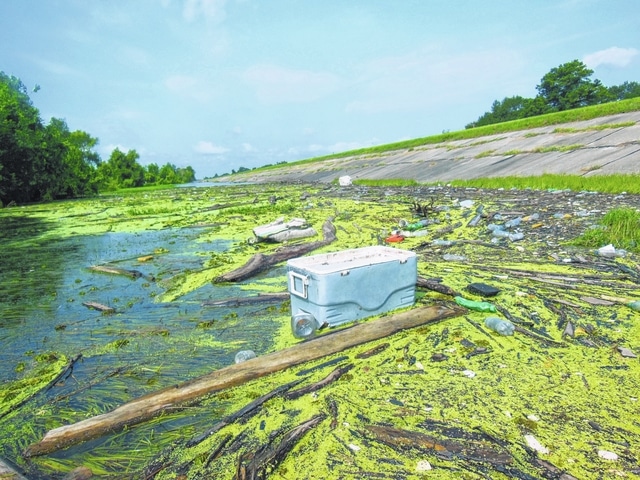
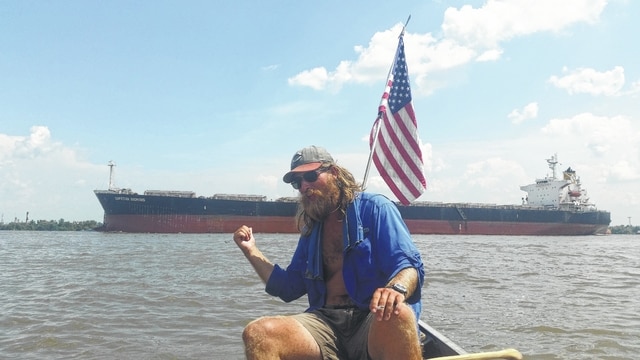
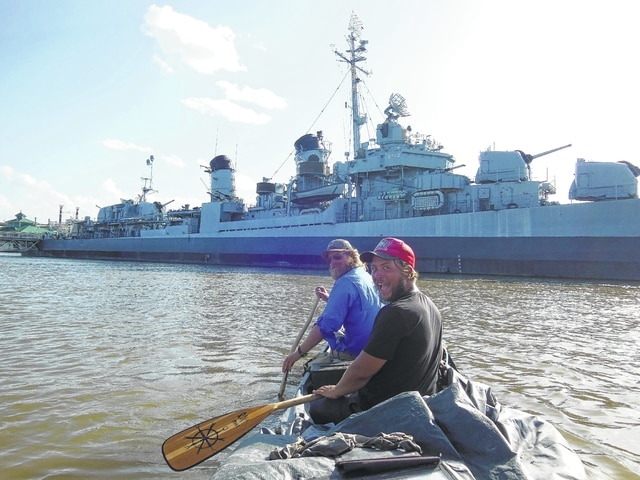
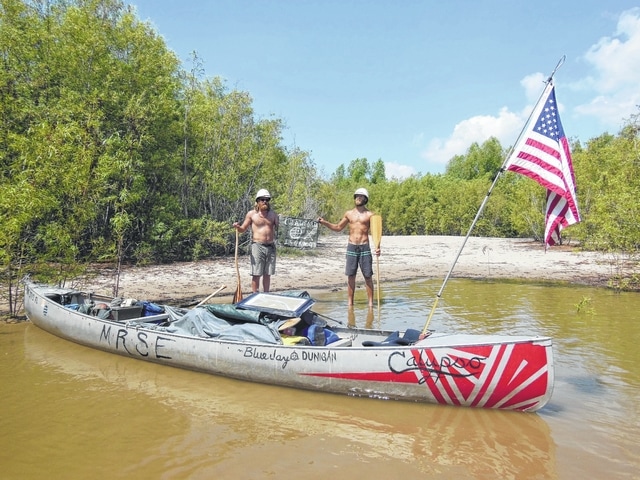
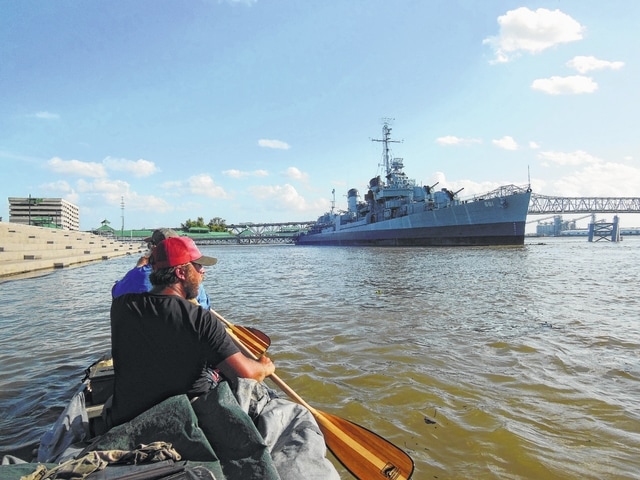
NEW ORLEANS — “We’re just a speck in the middle of the river, surrounded by massive ships.”
Those words, shared by Forrest Schoessow, 25, of Sidney, sums up traveling on the Mississippi River during the past week. Schoessow, Shea Selsor, 25, of Piqua, and Alex Ross, 26, of Sidney, landed in New Orleans Saturday after a harrowing and dangerous week of travel.
“We have watched the scale of the river change,” said Schoessow during their weekly phone call to the Sidney Daily News Sunday morning. “In Minnesota, we were the massive canoe at the beginning. We saw kayaks and smaller boats. Then we saw small barges. In the middle of the river we began seeing bigger barges.
“Once we got past Baton Rouge, the scale of everything changed,” said Schoessow.
The trio traveled 340 miles during the week. They have 93 more miles until they reach the Gulf of Mexico sometime Monday.
I’m completely exhausted,” said Schoessow. “I did not think it would be this hard. It’s hot and there’s been more traffic. The water is moving faster and it’s been more difficult.
Schoessow said he is mentally and physically exhausted.
“The heat and the sun have been brutal,” said Schoessow. “It’s been rough. Water is super important. We’ve been carrying 15 to 20 gallons of water with yes. Each gallon weighs 8 pounds.”
But with the heat of the day, the trio is drinking more water than any of them expected.
“Once what we have in the boat is gone, then we worry about finding more water that we can drink,” said Schoessow. “I’ve had a rough time the last couple of days. I’m on day three of having full body cramps.”
The cramps, he said, start at his feet, travel up his legs, back and arms, all the way to his head.
“It’s extremely painful,” said Schoessow. “And it’s also terrifying being in a boat. I know that if I were to fall in, I wouldn’t be able to swim.”
Schoessow said he’s also suffering from heat exhaustion and his body is having a hard time adjusting to the extreme heat, which is topping 100 degrees during the day.
“I’ve also been throwing up,” said Schoessow. “But we had to make the miles to get to New Orleans. I’m grateful to Alex and Shea. They have stayed strong and we have functioned as a crew. This has been a solid team effort. We are looking out for each other.”
The weather, said Ross, has been hotter and hotter with each day traveled.
“The sun is the real enemy,” he said. “We have water loss and salt loss. It’s difficult to replace them. We’re also suffering from heat exhaustion.”
Schoessow said he has lost 30 pounds during the trip.
“I’m excited to be close to the end. I’ll be able to get out of the boat and take care of my body,” said Schoessow.
Selsor echoed his traveling companions about how exhausted he is.
“It’s so hot down here,” said Selsor. “You can put up with it for awhile. We’re working hard in the heat and we’re doing it without the comfort of air conditioning and a bed at night. It’s hard to recover when you don’t have those.
“It’s pretty miserable being on the water,” he said. “But a day of rest was not in the cards if we wanted to meet our goal of getting to the gulf.”
The heat has taken its toll on them, Selsor, “especially this last week.”
The river’s traffic, he said has been ridiculous.
“We are constantly getting out of the way of ocean liners,” he said. “We can’t cool down because we can’t stop paddling.
“It’s terrible how hot it is. It drains you physically and dehydrates you,” said Selsor. “We try to cool down with wet rags. We’ve heard nothing but to stay out of the water. There’s bacteria and waste products in it. We heard there some bacteria from a testing facility that supposedly in the water.”
The disappearing wildlife is a concern to Schoessow.
“Since we passed Baton Rouge, there hasn’t been much wildlife,” said Schoessow.
the water quality may have something to do with that.
“We’re in a cancer belt of the country and people are afraid to touch the water,” said Schoessow. “New Orleans has a boil advisory. People are paying money to discharge their waste into the water. We’ve seen a lot of that. There will be massive waterfalls from the pipes coming into the water (Mississippi River).
They began their week in Vicksburg, Mississippi, said Ross.
“Layne Logue and my cousin, Nick Crossland (of Baton Rouge) paddled with us. We all jumped into canoes or kayaks and went about 18 miles together. Layne had to go back to Vicksburg but Nick stayed with us a while longer.”
The trio, said Ross, spent that night camping under the shadow of a nuclear power plan.
“The river is still very flooded,” said Ross. “We’re seeing more high ground, which is man made.”
The next stop on their week’s journey was in Natchez, Mississippi.
“It’s a beautiful city to come into on the river,” said Ross. “There’s old money here that dates back prior to the Civil War. At that time, there were 14 millionaires in the United States and 12 of them lived in Natchez.
“There are beautiful houses that look over the bluffs,” he said. “We met many great people here. Randy Laird, who is a guide, had a lot of knowledge about the area. The city is called the Pearl of the World. It’s on the latitude as Cairo, Egypt.”
Schoessow said Natchez is a fascinating town.
“But it’s money is earned through blood and the price of skin — slavery,” said Schoessow “It’s the cultural hub of the area. It was called the Grand Village because the Native American tribes came here and did their trading.
“The city has a dark history,” he said.
That night while they were camping, they noticed numerous holes in the ground.
“There were wild boars, armadillos and snakes which made the holes. Shea and Forrest checked out the hogs and stalked seven to nine of them while I was cooking.”
The wild boar, said Schoessow, can destroy the land quickly. The animal can smell things miles away and can remember where they smelled something if they need something to eat.
“They can root and dig out massive holes and pits,” said Schoessow. “I had heard them screeching and it has a demonic sound to it.”
He went into the swamp looking for them and found a herd of boars.
“I got close to them and decided I needed some reinforcement,” said Schoessow. “Shea went back with me. We were pretty hungry and were fixing to have a little bacon for supper. Since the boars destroy everything, there’s an open season on them all year long.”
Silently, the pair began stalking the herd.
“We were up to our waist in the swamp,” said Schoessow. “Shea was on the look out for gators ans snakes. We were able to sneak up on them (boars) and were able to separate a small animal from the herd. “
Armed with hatchets, they attempted to kill the boar, but “it slipped through us,” said Schoessow.
“I guess they didn’t want the noodles I was cooking,” said Ross.
Selsor also spotted an alligator walking around their camp one night.
As they traveled down the river, they still went into parts of Louisiana.
“We stopped at ‘Not Your Mama’s Restaurant’,” said Ross. “We camped out on a levee that night. When we left the next morning, a fisherman offered us a bucket of frog legs but we had to say no because we didn’t have any way to keep them cold.”
Traveling into Baton Rouge, the trio experienced their first ocean liners. The river, said Ross, was heavy with traffic.
“There was a horseshoe bend and there was a big ship there,” said Ross. “There were a lot more wakes. The towboats were also making it more difficult for us.
“My cousin (Nick Crossland) works at the campus there (Baton Rouge),” he said. “He put us up for the night. He made us a steak dinner since he wouldn’t be able to meet us in New Orleans.”
The look of the river is changing, said Schoessow.
“It’s extremely industrial here,” Schoessow said. “When we first started, I was excited about upper Minnesota and seeing the wildlife refuges and all the wildlife. I also wanted to see how the culture changes on the river.
“I as not prepared for this much industrial change,” he said. “After Baton Rouge, we started seeing ocean liners in addition to the barges and towboats.”
The ocean liners, he said, with their large propellers has caused problems for their canoe.
“The river banks have been fortified by the Army Corps of Engineers,” said Schoessow. “This makes the river very narrow. We’ve had barges on one side of us and ocean liners on the other.”
Because of the waves the larger vessels create, the trio has had problems with their canoe taking on water.
“We were trying to turn to the right side,” said Schoessow. “We had two barges passing us on the right side and an ocean liner on the left side. We got hit by their giant waves.
“It was like we were climbing a mountain,” he said. “The waves were taller than we. We got through the first one. Then the second one hit me square, picked me up and threw me into Alex.
“We almost went down. It was pretty terrifying,” he said. “The last couple of days have been the most dangerous part of the trip.
There were able to conquer two islands during their travels this week. The first, Crawford Island, was in honor of Dave and Mimi Crawford, of Piqua.
“It is a beautiful island north of Natchez. It was covered in fire ants but it was still beautiful. I say a coyote track and I startled it. He ran past me and swam to a separate island. It was tall and so skinny. There’s no food on the island. I felt bad for it.”
The second island was conquered for Claunch family, who are friends of Selsor.
“I went to school in Columbia with Will Claunch,” said Selsor. “I spend lots of time with their family. They were great to me.”
Coming into New Orleans, they hit a massive storm, which contained high winds and lightning.
“The worst wind rolled in,” said Ross. “It was a massive storm front. We were almost kicked under a dock. We tried to stay out of the way of the towboats and their PA systems”
“It’s incredible being here in the post of New Orleans,” said Schoessow. “We’ve seen gigantic containers, ships and dry docks. The next 93 miles will have more traffic and more ships going in and out of the gulf.”
Arriving in New Orleans has provided a boost for them as they were greeted by family and friends when they pulled into the dock.
“Some of them drove 1,000 miles to greet us. It was the greatest thing to come about the bend to see them waiting for us. Everyone was cheering and there were fireworks.
“Alex’s father was playing his horn,” he said.
While they were being welcomed by their supporters, he said, right behind them a tow boat lost control of the barges he was towing and hit a container.
“He just missed us,” said Schoessow. “It was pretty scary.”
For Ross, the stop in New Orleans meant coming home. Although he’s from Sidney, he resides in New Orleans.
“It was very, very good,” said Ross of pulling into New Orleans. “This is home for me. I’ve waited for this day since we were seven days into the trip.”
Saturday was the highlight of the trip for Selsor also.
“There was a storm brewing up so we were doing everything we could to get to shore. We knew there were tons of people waiting for us,” said Selsor. “We couldn’t see around the barges. Then the wind picked up.
“Then we heard the noise of cheering and applause. There were a couple dozen people waiting for us,” he said. “That was amazing. We ate dinner with them and they wanted to celebrate with us.
“We had to reluctantly decline and be the party poopers. They came all this way to celebrate with us and we had to turn that down. We knew we had to get back on the river.”
The welcoming group include Ross’s parents, Schoessow’s parents and Selsor’s mom and brother. His dad arrived in New Orleans Sunday. Some friends of Schoessow drove in from North Carolina to welcome them to New Orleans.
Ross said he will be spending a month working on the paintings he was to create from the sketches he drew during the trip.
The trio, after reluctantly getting back into their canoe, left New Orleans Sunday afternoon with their families driving down the Gulf of Mexico to meet them when they arrive.
“None of us want to get into the boat,” said Ross. “Right now we’re setting on a balcony overlooking the Mississippi River and enjoying not being on the water.
Their families will be waiting on them when they arrive at the Gulf of Mexico on Monday.
An update on their arrival at the gulf will be published in Wednesday’s newspaper. The final installment of their trip will be published in the Monday, Aug. 3, newspaper.
The trip can be followed on their website, http://mrexpedition.squarespace.com and on Facebook, https://www.facebook.com/m.r.s.expedition. The Sidney Daily News has also linked up with the expedition’s Facebook account on its site, https://www.facebook.com/SidneyDailyNews.









